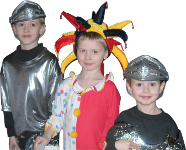Peter and the Wolf

The grandfather warns Peter not to go outside the fence because wolves will attack him. The grandfather's voice is represented by the bassoon. Unfortunately Peter disobeys his grandfather and leaves the enclosed area. I tell my children at this point that the remainder of the story is fantasy because Peter's disobedience probably would have resulted in his death, since there is no way on earth that a boy could capture a ferocious wolf. In the story, though, the boy has no consequences for his disobedience. This is the only bad aspect about this story, since I don't care about the wolf swallowing the duck.
So Peter leaves his home with his cat, who is represented by a clarinet. A bird in a tree (a flute) tries to stay away from the cat, who almost catches the bird. Then a duck (represented by an oboe) starts swimming around, completely unaware that it's about to be eaten by a ferocious wolf. The wolf suddenly enters the scene and gobbles up the unsuspecting duck. The wolf is represented by the French horn, and the resulting fight is interesting to listen to on the instruments.
Peter decides that he is going to catch the wolf, so he creates some form of trap involving a rope, and he supposedly catches the wolf by the tail. This is absolutely ludicrous, of course. He hears the hunters coming, who are represented by drums (or timpani). When the hunters arrive, Peter shows off that he has captured the wolf all by himself. When the grandfather returns from the store (or wherever he went, leaving his grandchild unattended at a young age, which was probably illegal), instead of disciplining the boy, he acts like he's proud of him. Oh, earlier in the story the grandfather came back from the store (or wherever) to yell at the boy for having left the fenced area. So I guess he got reprimanded. But this makes his second infraction all the more serious, since he disobeyed his grandfather twice. (The first time was before he caught the wolf, but after the duck had been swallowed by the wolf.)
Peter has a wonderful parade at the end, something he does not deserve whatsoever after being such a disobedient brat. The hunters parade after him, and all the animals (instruments) in the story follow him as he parades around, proud of himself.
Now that I've told the story, maybe this isn't such a great way to learn about instruments. But the greatest aspect about this piece of music is the fact that each instrument is separated out and can be represented by the characters in the story. And for that reason, even though it is a ludicrous story, I still recommend teaching children the instruments in this way. Besides, it's a famous song, so your children should be familiar with the song anyway, not to be ignorant.

